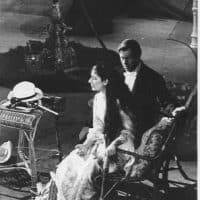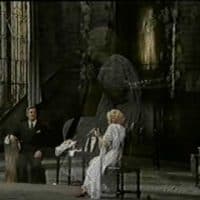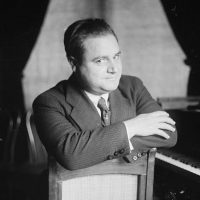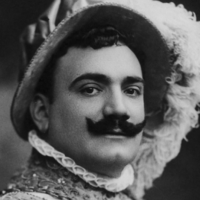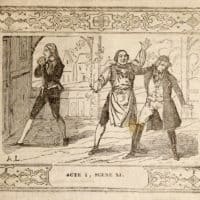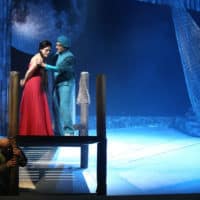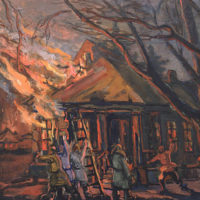Paris Opera, 2005. Annio lies next to Sesto as they sing a duet about their mutual affection. After the final notes, Annio rolls towards Sesto, places a blindfold over her eyes, and leans in for a kiss. As I watch the DVD, my brain struggles to label the romance of the moment. I’m seeing two women—both dressed as men and playing male characters, and both still obviously female. I also see two women in the scandalously erotic opening scene of Der Rosenkavalier, but in that case only one of them is wearing trousers (metaphorically—in point of fact, they are both wearing very little!). Does that scenario differ in any fundamental way? Does it deserve a different label?

We can try distinguishing between the world of the opera house and the world of the opera. In the world of the opera house, we might say, both examples show a lesbian relationship, while in the world of the opera, the scene from La clemenza di Tito is gay and the scene from Der Rosenkavalier is straight. Or we can throw up our hands and label it all queer. Opera famously has a large fan base who self-identify as queer in some way, after all, so we shouldn’t be surprised that the genre is inherently queer, too. But while queerness in opera certainly includes cross-dressing and ambiguously sexualized relationships, it’s a much broader concept. The delicious queerness of opera also involves paradox of creating realistic drama in which everyone sings everything; the mismatch between singers’ and characters’ appearances or ages; and the carefully trained use of the most natural instrument, the human voice.
At this point, I might give in, had wiser citizens of the internet not already solved my problem. They have coined a word that fits our scenarios precisely: mezzosexual. The term is doubly appropriate. In one possible reading, the “mezzo” refers to the in-between-ness of the sexuality itself. A person or scene that is mezzosexual is not quite homo-, hetero-, bi-, or any other “sexual,” but rather somewhere in the middle of all of those labels. In another reading, the “mezzo” is a nod to the voice part of the singers who typically wear the trousers and create such wonderful erotic confusion—mezzo-sopranos.

When the label “mezzosexual” is used by opera fans to refer to themselves, it is usually contrasted with their everyday sexuality. The term includes an aspect of surprise, and it is that surprise that leads to the search for a label. But anyone can be surprised by mezzosexuality. Whatever gender(s) a listener is usually attracted to, “women dressed as men wooing other women and singing in a low range” is just odd enough to fall outside of that category. A straight, female audience member like me might be puzzled to discover she’s attracted to mezzos playing trouser roles and turned on by those mezzos’ onstage interactions with the (female) objects of their affection. A lesbian audience member who does not find drag attractive in everyday life could be astonished to find herself drawn to mezzos dressed as men. Male opera fans of all sexual orientations can also discover that they find women playing men making love to other women surprisingly erotic.
Of course, it’s not all about the clothes and the sex. The eroticism of mezzosexual scenes also stems from the music. These scenes provide an opportunity for female voices to sing together passionately. And in these moments, they do not sing about flowers or an absent (male) third party—they sing to each other. Their voices cross, echo, and join. Consider, for instance, the duet “Ah, perdona al primo affetto” in La clemenza di Tito. Annio sings first, his melody doubled below by the bassoon. Servilia echoes the same melody with different lyrics, this time with the flute playing above her. (The instruments subtly indicate the different-gender characters despite the same-gender singers.) When they sing together, they are initially only a third apart, but they split to more than an octave apart during ‘Quando un alma è all’altra unita, / qual piacer un cor risente,’ as though to emphasize that they have been separated and are no longer supposed to experience the unity about which they’re singing. This painful separation is followed by a musically and dramatically satisfying conclusion: They finish the duet on the same pitch in the same octave, together not just in spite of, but because of, their shared femaleness.
The operatic canon is full of moments like this, and it’s tempting to compile a catalogue of duets, scenes, and stagings that cater to mezzosexual tastes. The 1999 production of Alcina at the Stuttgart Opera would undoubtedly make the list, as would quite a few numbers in La clemenza di Tito and Idomeneo. The entirety of L’incoronazione di Poppea and Giulio Cesare would also earn spots, with a “no countertenors allowed” caveat. (I’m not against them generally, but they have no place in our imaginary catalogue.) And we can’t forget the beginning of Der Rosenkavalier, which Terry Castle so beautifully described long before internet fangirls coined a term for her intoxication:
What we see before us—in the intoxicating boudoir scene at the start of Rosenkavalier—is Fassbender, the diva, draped langorously across another, making passionate love to her. No matter how artfully ‘true to life’ the boyish gestures, Fassbender-in-drag fools no one: the fact that the body is female, that the voice is a woman’s voice, remains inescapable… The very butchness with which she tackles, say, a role like Octavian—the sheer, absolutist bravado of the impersonation—infuses it with a dizzying homosexual charge. (“In Praise of Brigette Fassbender: Reflections on Diva-Worship” in En Travesti: Women, Gender Subversion, Opera, p. 42)

For further candidates for inclusion, we have only to look to the Who Wears the Trousers? Tumblr, a collection of photos and videos of mezzos in pants roles. The wide variety of scenes, productions, and singers on display proves that our catalogue will be a long one.
And yet—as pervasive as mezzosexuality seems in the world of operatic fandom, it is a fragile thing. The entire existence of mezzosexuality is predicated on three elements: the interplay between an actor’s gender and a character’s gender; the ambiguous romantic and sexual situations that result from actor-character gender mismatch; and the intertwining of female voices. As a result of this dependence on music and theatricality, mezzosexuality does not and cannot exist outside of an operatic context. We opera lovers have discovered (invented?) a beautiful, bewildering sexuality. And we’re keeping it for ourselves.
